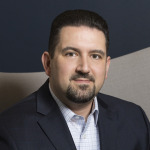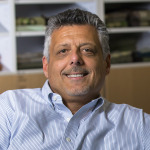We use cookies to maximize your online experience with us. By closing this window, you consent to our cookie policy. You can change your cookie settings in your browser any time. For more information, please see our Privacy Policy located on the footer of this site.
Collaborative + Integrated Team = Collaborative + Integrated Technologies

George Meglio, director of workplace technology, and Rob Newell, executive vice president of IT, both joined dancker in 2016 and now lead an integrated team of technology professionals that is a rare find in the furniture industry. While George focuses on sales and Rob on operations, both work directly with dancker’s clients to integrate solutions that drive performance – something they do directly for dancker, too, thanks to their simultaneously inward- and outward-facing roles. In a recent interview, George and Rob shared their perspectives on what this means for dancker’s clients today and in the future.
Both of you have decades of experience with technology that you now apply to your roles at dancker. What excites you about your current roles?
ROB: I’ve been in the commercial interiors industry for a long time and have seen firsthand the significant positive impact that technology has had on the evolution of workspace design and how people work. I am very fortunate to be able to wake up every day and love what I do. But now more than ever, it excites me that technology is such an integral part of dancker’s growth strategy. It’s not an afterthought or an add-on; it’s an important part of everything we do as a company. It’s incredibly rewarding to be able to deliver meaningful and effective solutions for our customers, and to help dancker succeed at the same time. We’re a 189-year old company that operates like a startup – willing to take risks and explore innovation – and that’s very appealing.
GEORGE: We go deeper into the design process than a typical AV design firm might. Like Rob said, we’re not an afterthought. In years past, I would be called into a project when it was already 60% complete. Now, I’m involved from the start. Technology affects almost every part of a project – the physical structure, the electricity, the furniture – so we have to be integrated in order to be efficient, not to mention cost effective. Technology is expensive, but it’s a lot easier and more affordable to install a piece of technology that’s been part of a design from the beginning rather than reconfiguring and retrofitting it later.
ROB: There was a great quote from Steelcase’s vice president of global marketing, Allan Smith, in a recent article in Steelcase 360 Magazine. He said “a lot of people drive a smart car and go to work in a dumb office.” It’s so true, and it’s why we’re focused on helping our clients develop smart offices, too. Technology makes the workplace relevant again, and overall empowers a better experience.
Your in-house IT and client-facing AV teams have recently been integrated at dancker. What does that mean in terms of the services you now provide?
GEORGE: When you boil it down to the technologies involved in today’s workplaces, IT and AV are one and the same. All of our technologies are collaborative in nature and integrated into the modern workplace. This demands a more collaborative approach. We’re no longer an add-on, but we are a value-add. And as an integrated team, we can offer our clients the benefit of our own first-hand experience because we use the same technologies that we sell.
ROB: The lines between IT and AV have blurred as the technologies have evolved from standalone systems to being fully connected across the network. We didn’t merge our groups so much as we simply integrated necessary skillsets to serve our clients, who are often corporate IT departments. We speak their language, which helps them relate to us better, and us to them. We can provide a more seamless experience because our roles are now both inward and outward facing.
It sounds like you’re consulting, rather than selling.
GEORGE: You can buy desks and monitors anywhere, but dancker provides real customer service as a trusted advisor. We are selling solutions, and in order to know that we’re selling the right workplace technology solutions, we work with our clients in a very consultative nature. For any project to succeed we need to understand deeply what the client wants to achieve. We observe closely and tailor each solution. And based on our team’s first-hand experience with the technology, we have the built-in support to show clients how things work.
What kind of technologies are clients asking for today?
GEORGE: One of the biggest challenges we’re asked to help our clients overcome is the multi-generation workplace. A recent college graduate connects and communicates differently from a baby boomer. Figuring out the right solution that helps those generations (and everyone in between) work side-by-side is part of our consultative approach. We can also leverage our own office – our experience center – to let clients test drive new technologies. We face many of the same challenges that our clients face, so we can test things on ourselves first, and then share the results with our clients for their own consideration. Our president and CEO, Steve Lang, recently wrote about this too: our own office is like our laboratory where we look very closely at what we do and how we do it – just as we do for our clients. This process of observation and analysis ensures that each workspace is functional and effective, and that technology is supporting the overall mission to connect people and purpose.
ROB: In today’s workplace, everything needs to be connected and controllable as part of the “internet of things” but to George’s point, it’s not about adding more gadgets or bells and whistles, it’s about connecting people, and maximizing effectiveness. Our clients want to understand how their space is being used, and if they’re getting an ROI on their real estate based on productivity and efficiency. Sensors can be employed to help them do that, generating real analytics. And because technology is integrated into the space, it facilitates flexibility when the data suggests that changes should be made. Technology also facilitates connection and collaboration and allows people to work in their own way – again easing that flexibility and mobility.
What do you see as the next big thing?
GEORGE: The analytics that Rob is talking about will become more and more important, ensuring that technology and the space it occupies are contributing to a company’s performance. Technology plays a part of everything we do, and data ensures that it’s working for us, rather than the other way around. It’s exciting to be at the forefront.
ROB: The “next big thing” is coming nearer, faster; it’s no longer just the stuff of movies. We’ve already helped clients incorporate science-fiction style technology from partners like Oblong into their space. We’ll see more of this in the very near future as facial recognition, tones and gestures become more common means of interacting with computers. On the surface it may appear as if technology is taking over, but in truth it’s allowing the interactions to become more human.
|
Rob Newell |
George Meglio |
Connect with George and Rob and share your thoughts on #people #technology and #futureofwork


